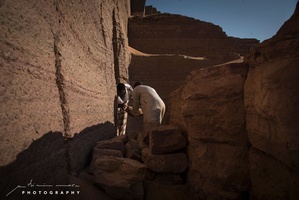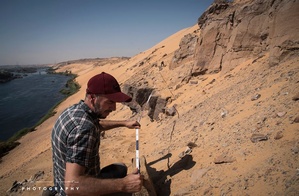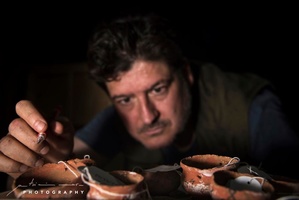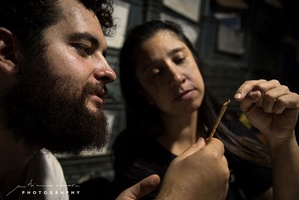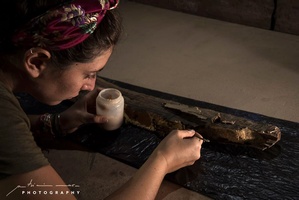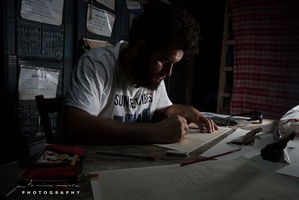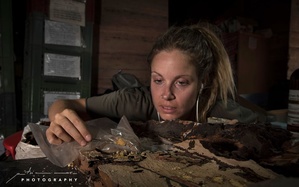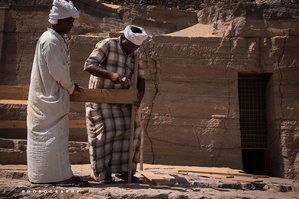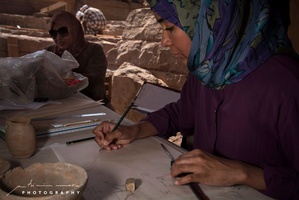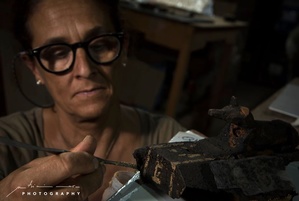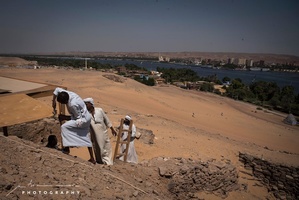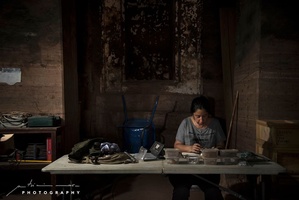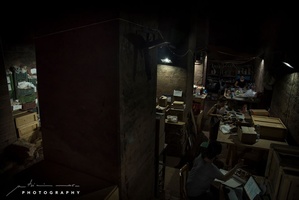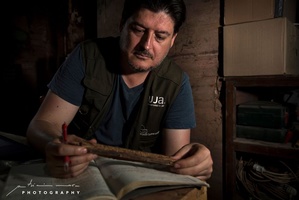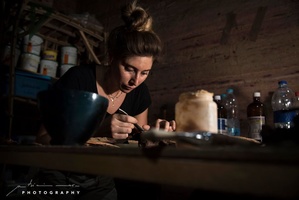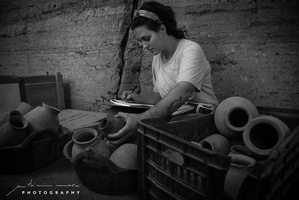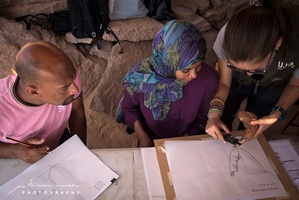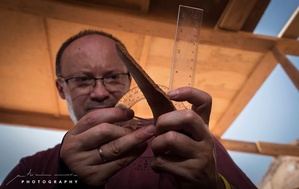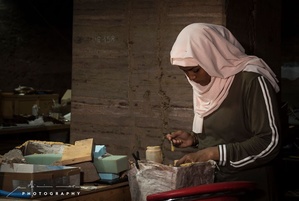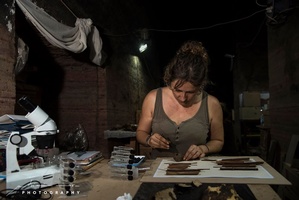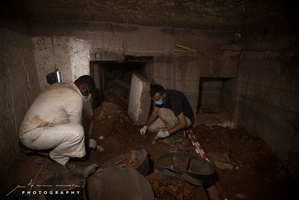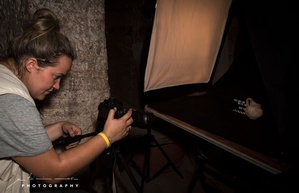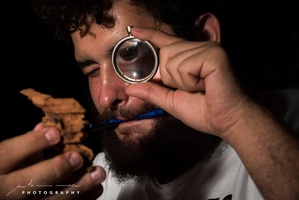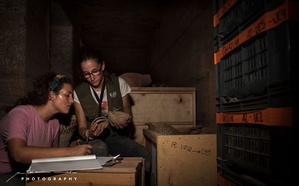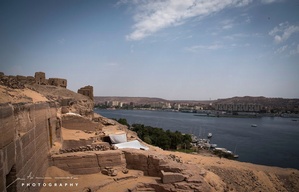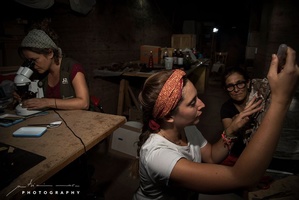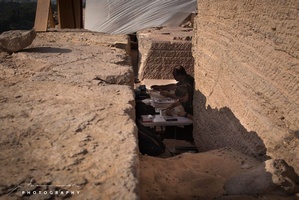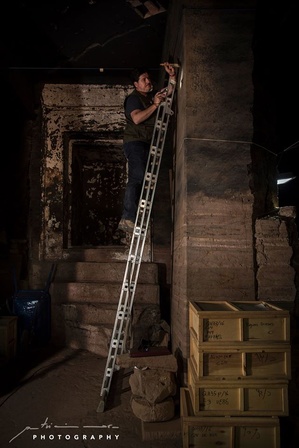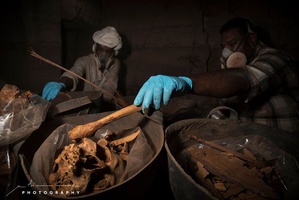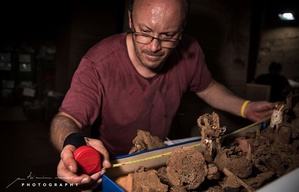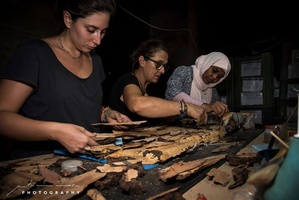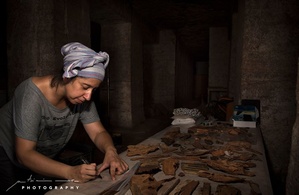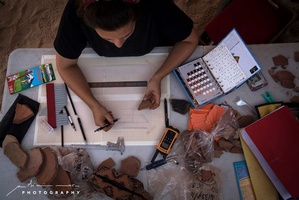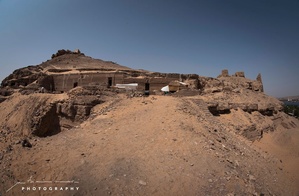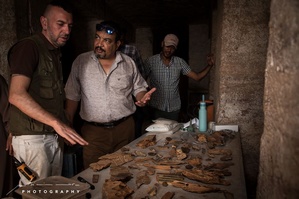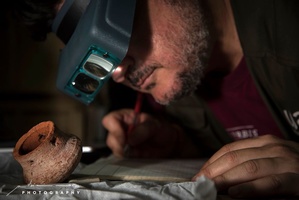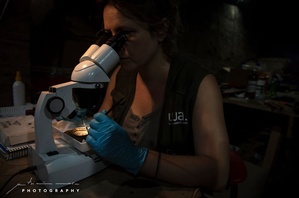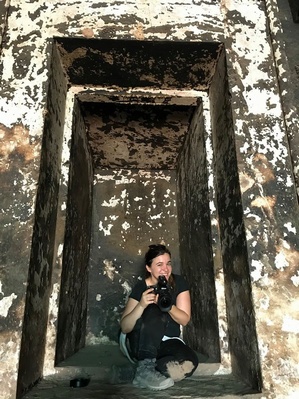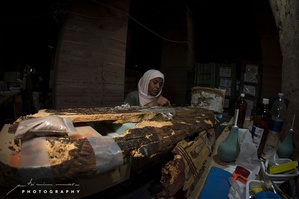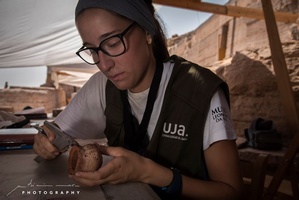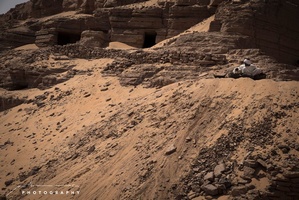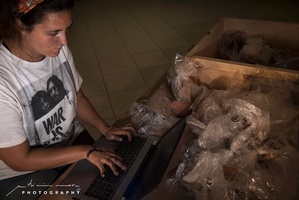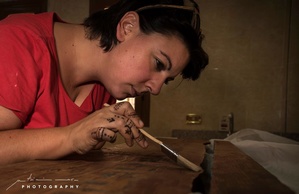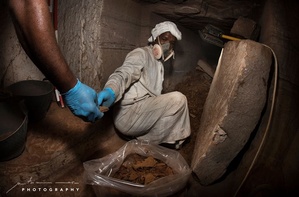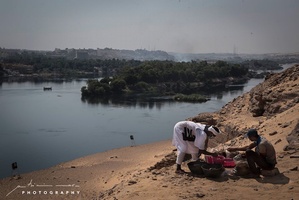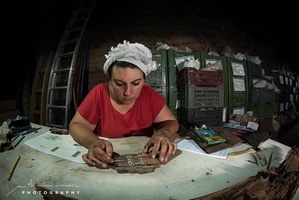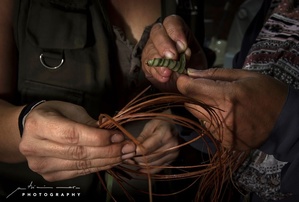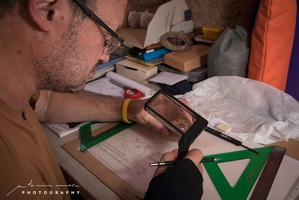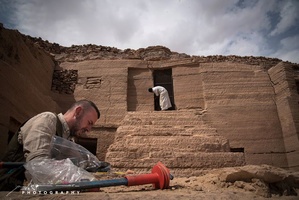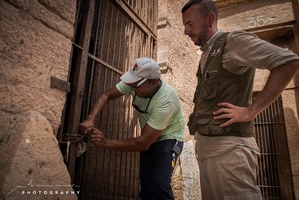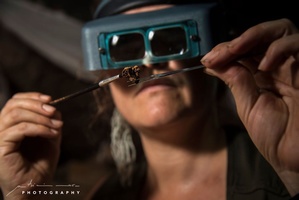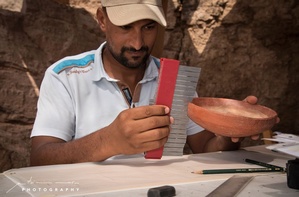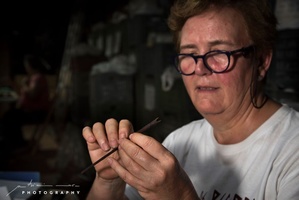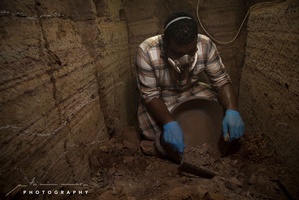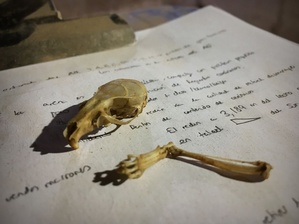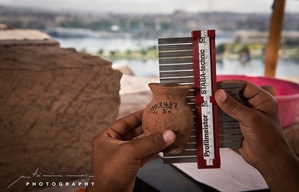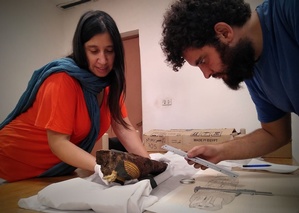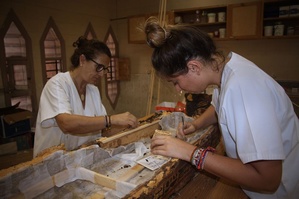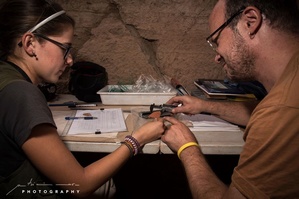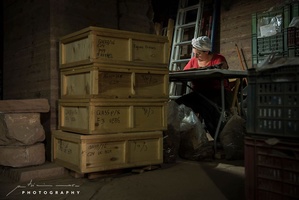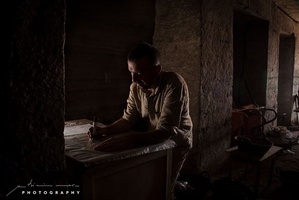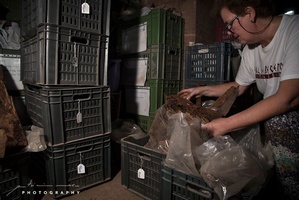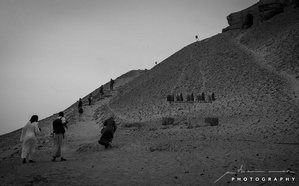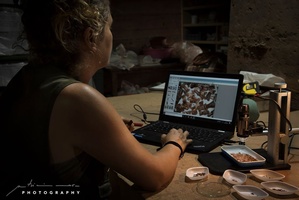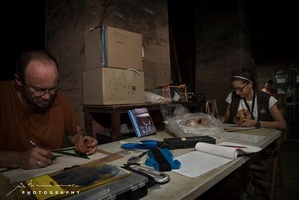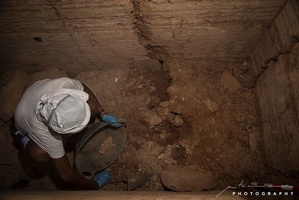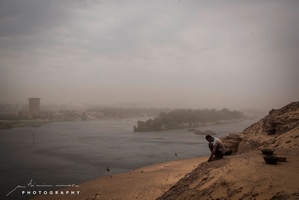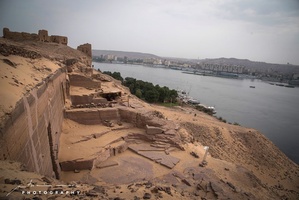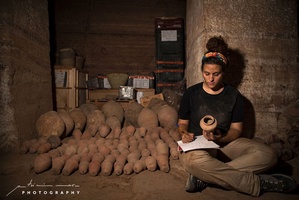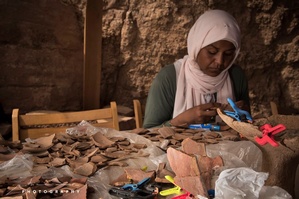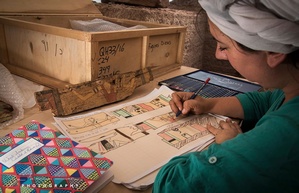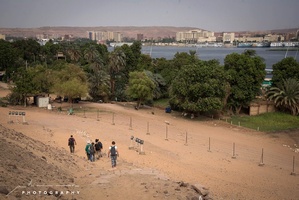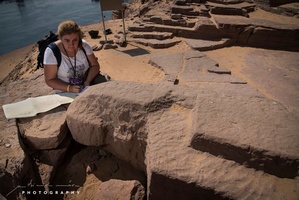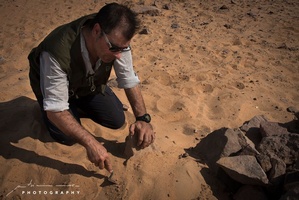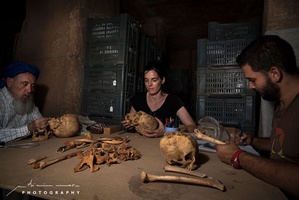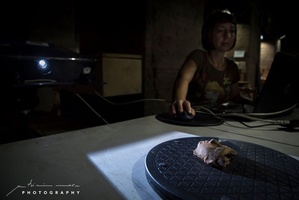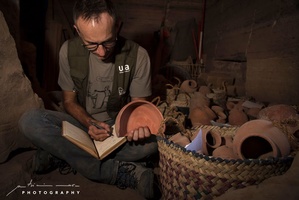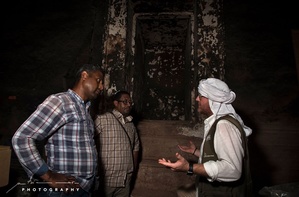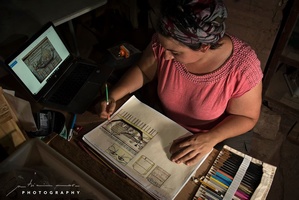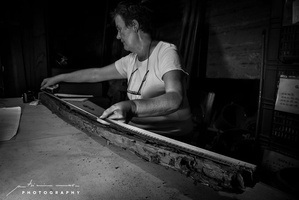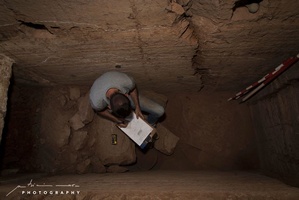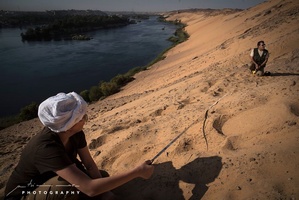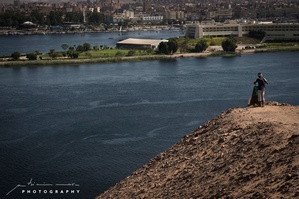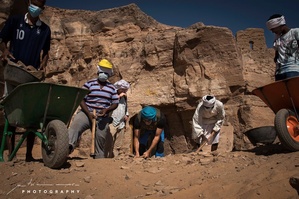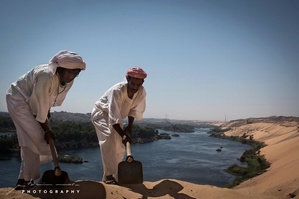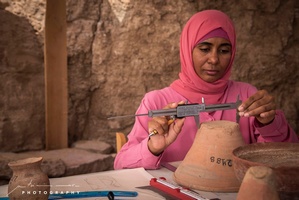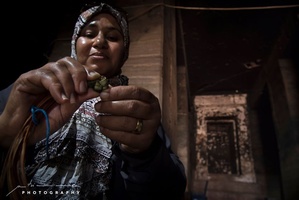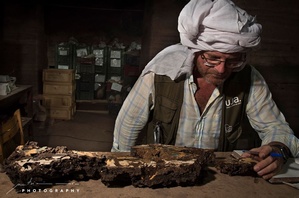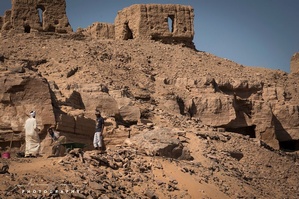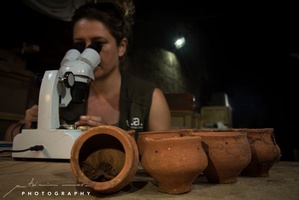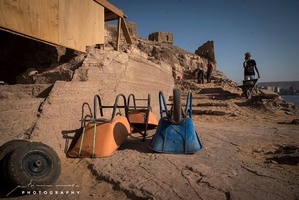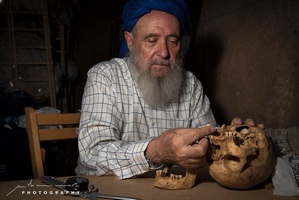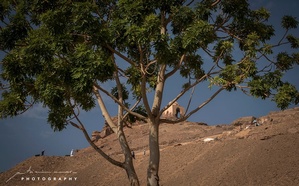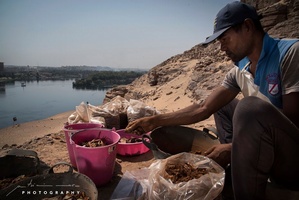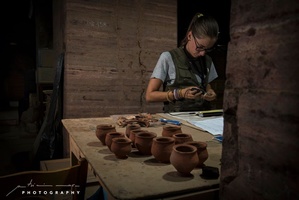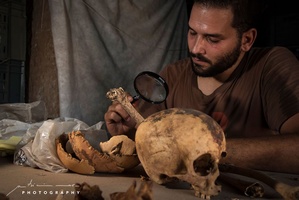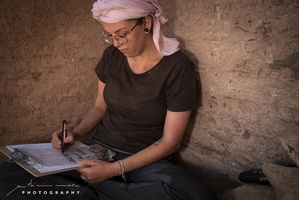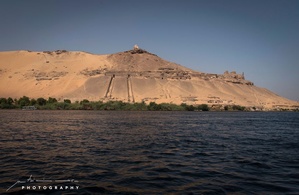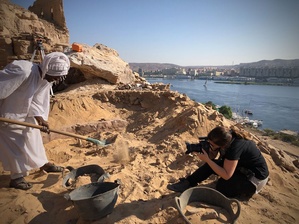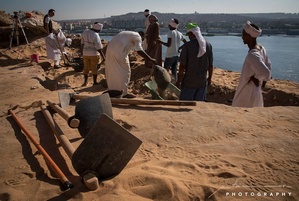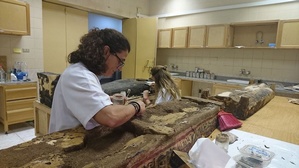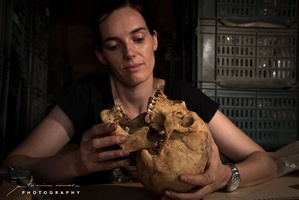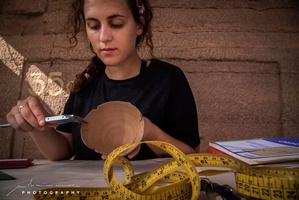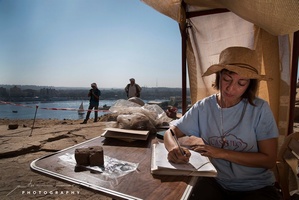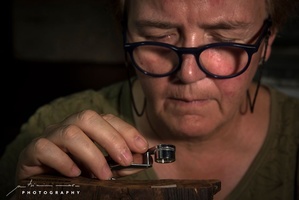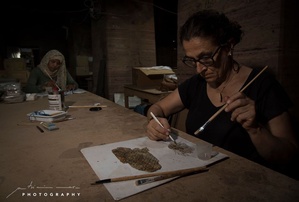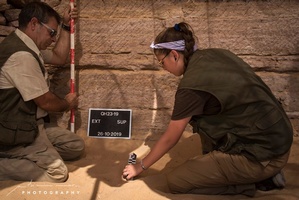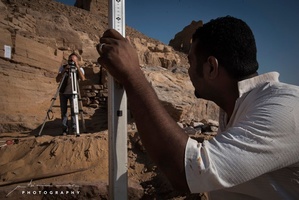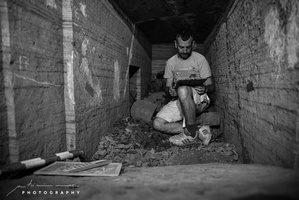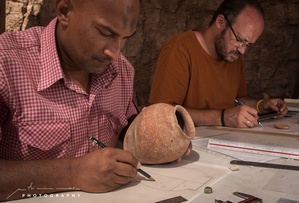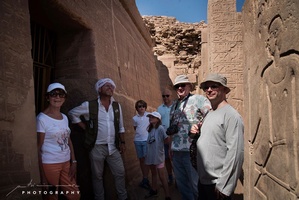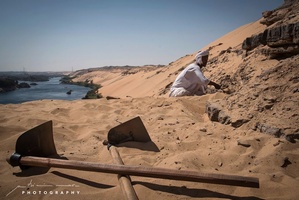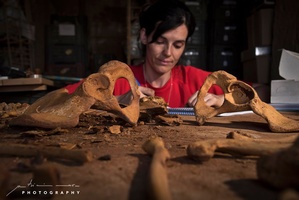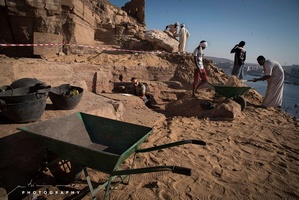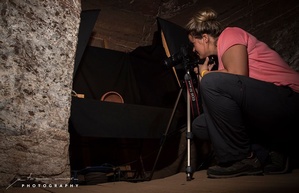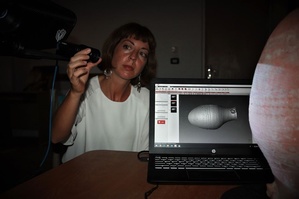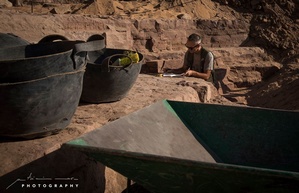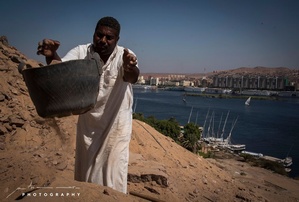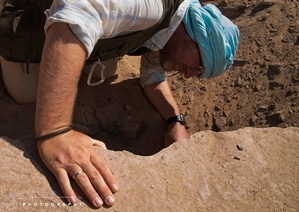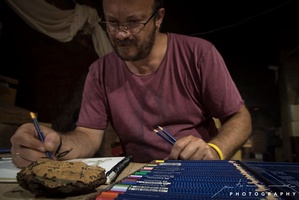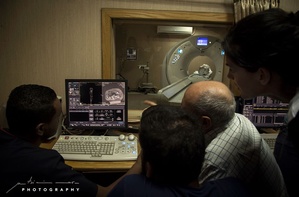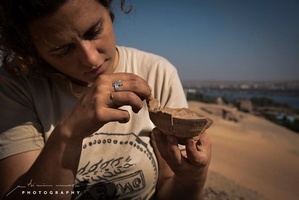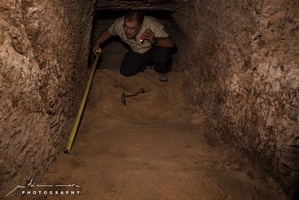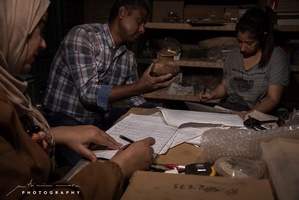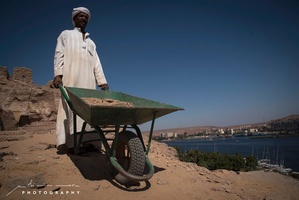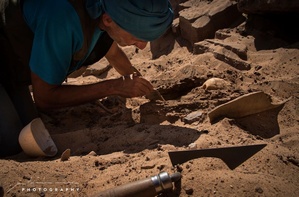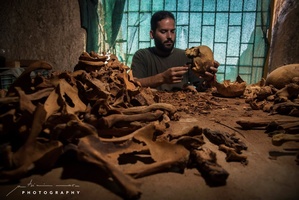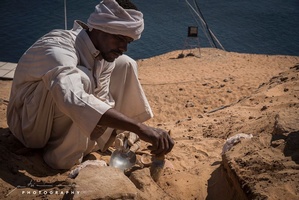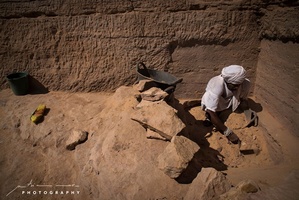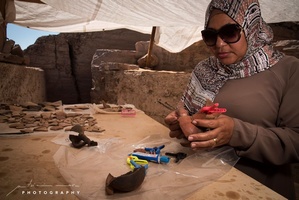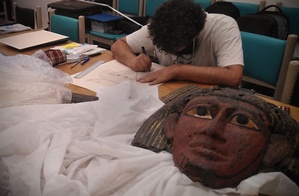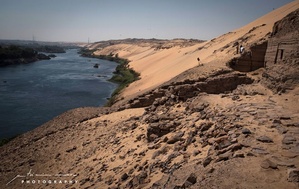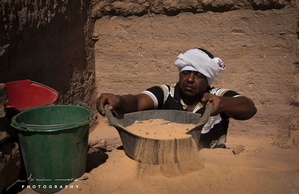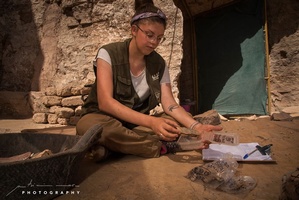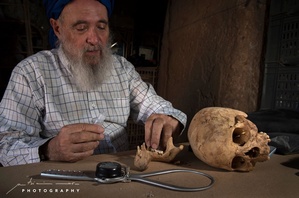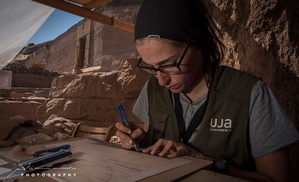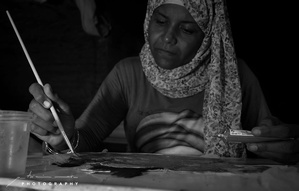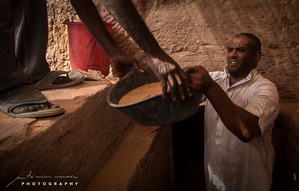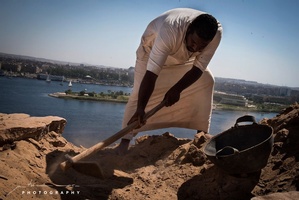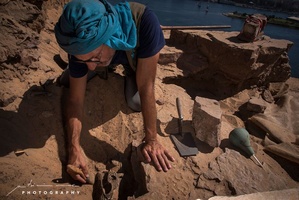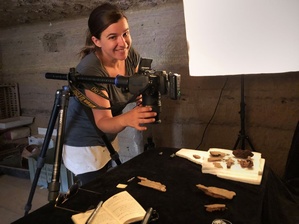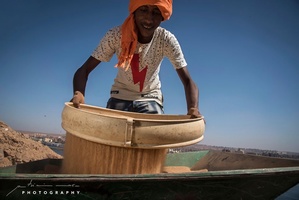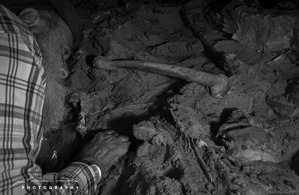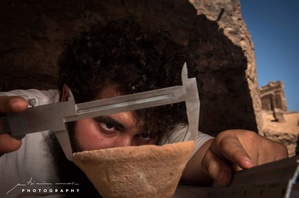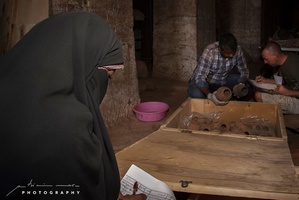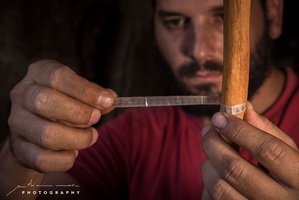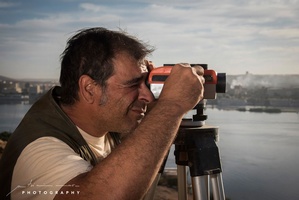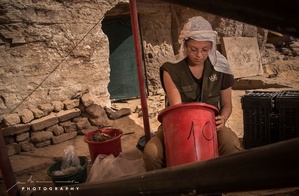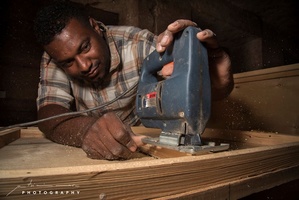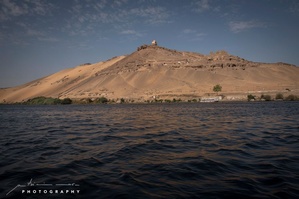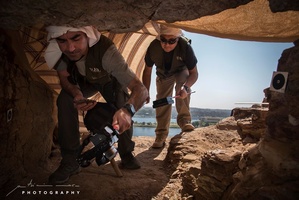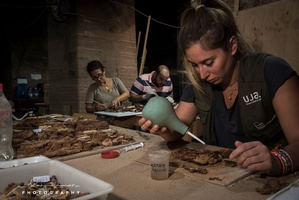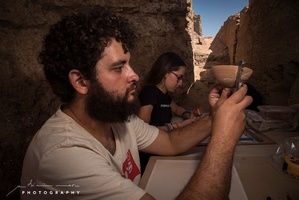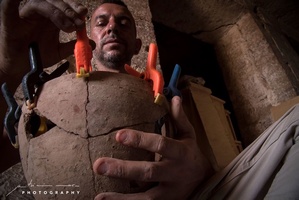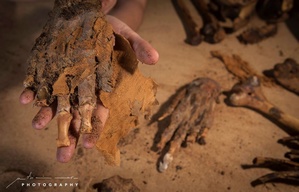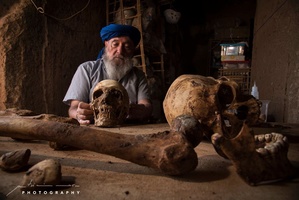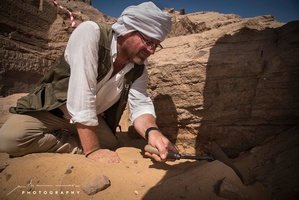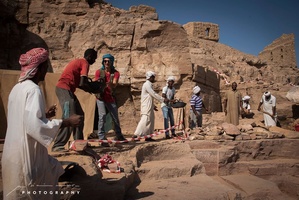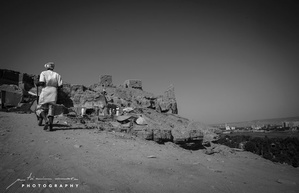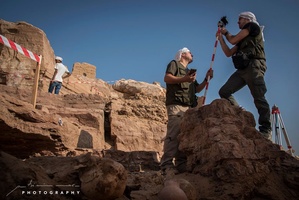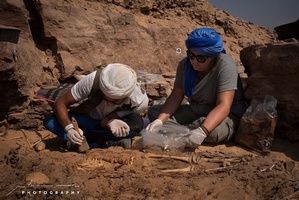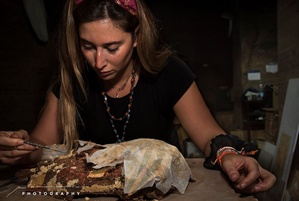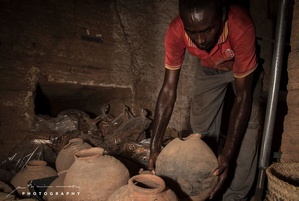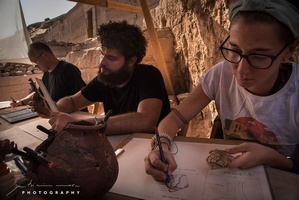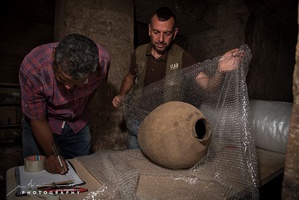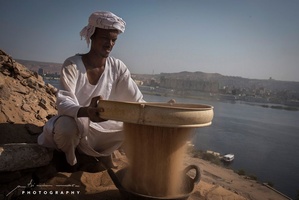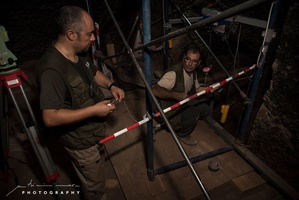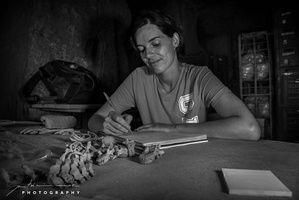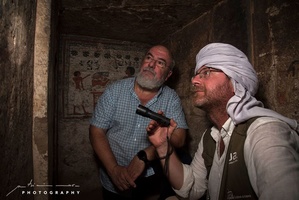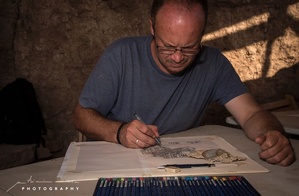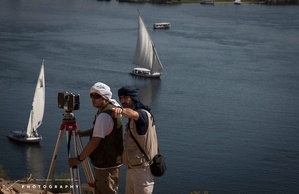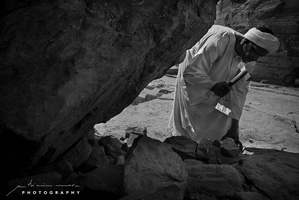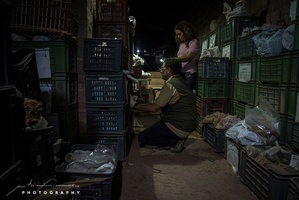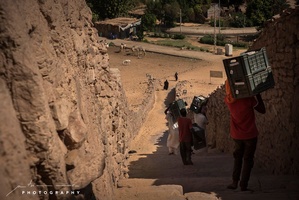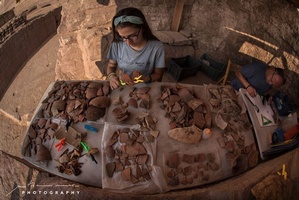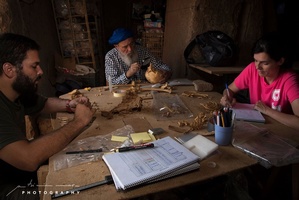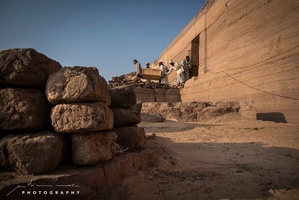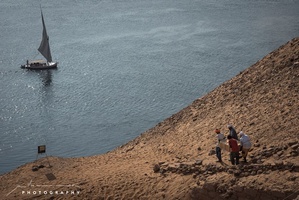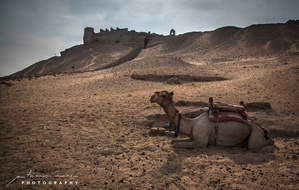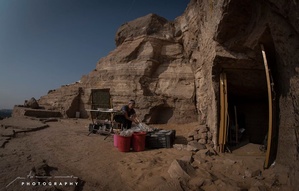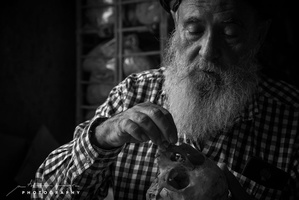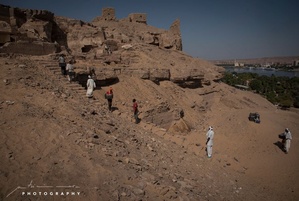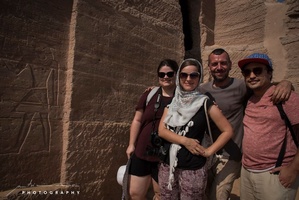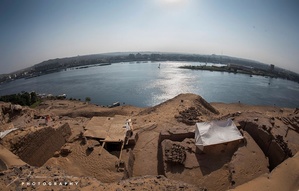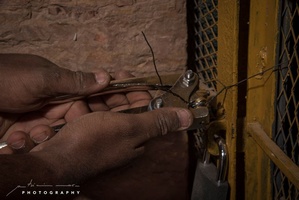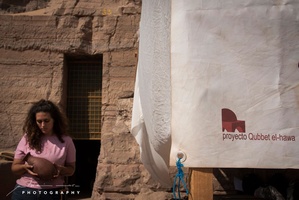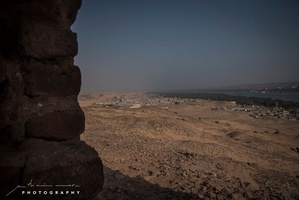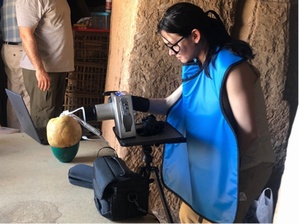Day 1
The team of the Proyecto Qubbet el-Hawa, from the University of Jaén, started its 11th season at the site today. Photography: Patricia Mora.
Mahmoud and Nuri, the local Nubians working with us, removed the stones blocking the entrance of tomb QH33.
The co-director Jose Alba Gómez and Antonio Morales made the first measurements of the new area located to the south of the tombs of Sabni and Mehu.
Antonio Morales, one of the epigraphists of the project, has initiated the analysis of the hieratic texts in some pots discovered last year at tomb QH33.
Fernando Luque, draughtsman, and Yolando de la Torre, egyptologist, sorting some artefacts to be drawn.
Restoration work started at QH33: Sara Tapia is working in the conversation of the coffin of Paefi.
Day 2
Despite the hot weather, the team is pleased to work at the site. Photography: Patricia Mora.
Fernando Luque is drawing some of the Late Period coffin fragments found during past seasons at the main shaft of tomb QH33.
Rebeca Hernández is restoring a coffin, found in a very poor state of conservation in the tomb QH33.
Nuri and Mahmoud building a tent, for the ceramologists arriving tomorrow, at the unfinished courtyard of tomb QH33.
Noha and Heba drawing some of the pots found during the works of Elmar Edel.
Our Restorer, Teresa López-Obregón, is working on the conservation of a Late Period funerary box.
Day 3
First week is over and we are already looking forward to next week's work and welcome at the site the new researchers. Photography: Patricia Mora.
In this astonishing landscape, the Proyecto Qubbet el-Hawa has been developing its work during the past eleven years. In the foreground it's located the Nubian village, in the background the city of Aswan.
At the pillared hall of the tomb QH33, Yolanda de la Torre is cataloguing some of the finds found in QH33 last season.
A second view of the pillared hall of the tomb QH33 where the restoration lab is located.
During the archaelogical works in the tomb of Sarenput II (QH31) appeared some polychromed fragments of small boxes inscribed, and Antonio Morales is in charge of its study and translation.
Thanks to one of our sponsors, Gaselec, the restorer Sara Tapia joined our team last year to help us with the coffin's and other finds restauration.
Day 4
Today, under an unforgiving Aswan sun and heat, work at Qubbet el-Hawa has begun once again with the arrival of further team members. Photography: Paticia Mora.
Ana is concentrated making an inventory of all the ceramic pieces documented by Edmar Edel during his excavations at Qubbet el-Hawa.
Meanwhile, Desirée continues her work documenting and studying the pottery remains of tomb QH33. And, at the same time, she helps and trains Egyptian inspectors in the methodology related to drawing and identifying these types of objects.
Francisco, a new member of the drawing team, spent his first day of the season with Desirée documenting and drawing pottery finds from tomb QH33.
On the other hand, the restoration team continue their hard work reconstructing Paefi's coffin. In this photo, we appreciate Shiri Han concentrated in her task.
Finally, Eva Montes, the team's carpologist, has started-off documenting samples found during last years campaign from QH32.
Day 5
Although today was a bank holiday in Egypt, work at Qubbet el-Hawa never ceases and everyone carries on with their investigations despite the heat, onge again. Photography: Patricia Mora.
Tomb QH32 is buzzing with archaeological activity with Jose Alba leading the excavation of one of the tomb's shafts.
In the meantime, Proyecto Qubbet el-Hawa continues to welcome more team members with the arrival of Gersande Eschenbrenner-Diemer, expert in ancient Egyptian woodcraft. Today, she has been working on one of the most exciting discoveries from 2017’s campaign: (Ii)-Shemai’s wooden models.
Additionally, Jennifer Colás, one of this year’s newest team incorporation, is working in the photographic documentation of ceramic pieces found in tomb QH36.
Continuing with his work in drawing coffin fragments from tomb QH33, Fernando Luque is keen on capturing every possible detail of each piece.
Finally, the endless ceramic study continues at Qubbet el-Hawa. This time, Desirée Pérez helps Ana Díaz finish with the inventory of Edmar Edel’s pottery finds.
Day 6
The week slowly carries on, along with the excavation works at Qubbet el-Hawa. Photography: Patricia Mora.
Even during a very hot day, as the ones the team has endured, everything seems less stressful with the views that they enjoy. Here, the Nile as viewed from the southern area of Qubbet el-Hawa. In the image, it is possible to see the entrance of tomb QH32 and the haima’s where part of the pottery team and Gersande Eschenbremmer-Diemer work in the courtyard of tomb QH33.
Sara Tapia and Teresa López continue their hard work in preserving Paefi’s coffin. In the same location, Eva Montes is concentrated in studying the basketry remains from tomb QH36.
Meanwhile, in the courtyard of tomb QH33, Francisco Javier Sánchez and Desirée Pérez continue their pottery drawing tasks documented during last year’s excavation works of this tomb.
Antonio Morales, on the other hand, spent part of his morning searching for ancient graffiti that could have been written under the burnt layer of the walls of tomb QH33.
Day 7
The first week of the season is almost coming to an end, and the team of Proyecto Qubbet el-Hawa continues with their hard work. At the moment, the archaeological works are concentrated at QH32, QH33, QH35p and QH36. Currently, the team’s main objectives are the study of the materials documented in past seasons. Photography: Patricia Mora.
Gersande Eschenbrenner-Diemer carries on with her exciting documentation and study of (Ii)-Shemai’s funerary wooden models.
She is also receiving some help from Francisco Javier Sánchez, who took a small break from ceramic pottery and has been assisting with the documentation of other archaeological objects. In this case, he is measuring one of (Ii)-Shemai’s wooden models to reconstruct their original design.
Meanwhile, in the restoration laboratory of QH33, Sara Tapia and Teresa López persist with the difficult task of preserving Paefi’s coffin. They count with Shiri Han’s help.
In the meantime, in QH32, while the excavation work persists, Yolanda de la Torre spent her morning sorting coffin remains, mummy dyed bandages and other materials documented there.
Finally, Ana Díaz has returned to the northern area of Qubbet el-Hawa and has resumed her duties of studying the Middle Kingdom pottery remains of tomb QH35p.
Day 8
Slowly, the work at Qubbet el-Hawa progresses and each team member carries enthusiastically with their research. Photography: Patricia Mora.
Here part of the southern area of the necropolis, where most of the work from the Proyecto Qubbet el-Hawa’s team develop their research and they continue with the archaeological works.
Jose Alba carries on with the excavation at tomb QH32. Amongst the numerous finds he has been documenting, he is explaining a group of coffin fragments to Dr. Abdel-Moniem, general director of Aswan and Nubia of the Ministry of Antiquities who grant us a visit this morning to see what research we have been developing at the site.
Finishing with his study concerning the spice pots documented last year at tomb QH33, Antonio Morales spent his last day of the season analysing the epigraphic traces written in these vessels. From the Proyecto Qubbet el-Hawa, we wish him a safe trip back to Madrid.
Eva Montes continues with her research on basketry remains found in tombs QH32 and QH35n.
And finally, we present Patricia Mora, the person who is in charge of taking the pictures of all our adventures here at Qubbet el-Hawa. We could not have wished for a better photographer and friend!
Day 9
Today was one of the hottest days of the season so far. Despite being Thursday, the last work day of the week until Saturday, the work at Qubbet el-Hawa never stops. Photography: Patricia Mora.
At the site, the restoration team, with the help of Shiri Han, continue with the complicated preservation of Paefi’s coffin.
On the other hand, part of the pottery team has started drawing the spicy pot group that was found last year during the excavation of tomb QH33. Here, Desirée Pérez carefully documenting one of these pots.
QH32 continues with its busy archaeological works. Bilal, one of the Egyptian workers, sieves the buckets that come from the excavation area so that no material gets lost in the way.
Meanwhile, part of the team had to move to the Aswan magazine and the museum, to finish off some of the research and documentation of some pieces which are kept there. Ana Díaz is making an inventory of the ceramic vessels from tomb QH33 that were transported to the magazine last season.
Finally, Gersande Eschenbrenner-Diemer, who also spent her morning in the magazine, finishes her study (Ii) Shemai’s coffins that were found in previous campaigns.
Day 10
Saturday’s are the new Monday’s for the Proyecto Qubbet el-Hawa, so we began our work week with recharged energy after our well-deserved break on Friday. Photography: Patricia Mora.
QH32 carries on with a frenetic archaeological activity. Nuri helps Jose Alba in the excavation of one of the funerary chambers.
Meanwhile, Bilal and Hassen, continue to separate the small finds among the fragile a mummy bandages retrieved from the dig of the funerary chamber, so no material gets lost on the way.
In tomb QH33, Gersande Eschenbrenner-Diemer documents and studies Middle Kingdom coffin remains from last season’s campaign in QH33.
Also, in the same tomb, Eva Montes is currently working on basketry remains of several tombs. She has asked Noha, one of our Egyptian inspectors, to show her the traditional way of making and weaving basketry.
Finally, Francisco Javier Sánchez continues to document and draw the multiple spicy pots found last year during the final excavation of tomb QH33.
Day 11
After some technical problems caused by a small sandstorm yesterday evening, the day’s work continued at Qubbet el-Hawa. Photography: Patricia Mora.
Part of the morning was spent changing the locks of most of the tombs from the site. Here Jose Alba is supervising this task at tomb QH35.
Also, Mustafa and Jose Alba in tomb QH35d, where Pepinakht-Heqaib was buried. This is an important duty to keep updated because it secures the well-being of these tombs.
Back in tomb QH33, Eva Montes carries on her research in ancient Egyptian ropemaking with samples from the excavations of tomb QH33.
In this tomb’s courtyard, Egyptian inspectors train in ceramic studies by drawing the well-preserved pottery documented by Elmar Edel.
Finally, Proyecto Qubbet el-Hawa welcomes gladly new team members. In this case, Oliva Rodríguez, the team’s anthracologist, begins her research with samples from tomb QH33.
Day 12
Slowly but steadily, work at Qubbet el-Hawa carries on while we wait for the arrival of more team members this week. Photography: Patricia Mora.
QH32’s activity is quite active. The excavation of the funerary chamber and shaft led by Jose Alba, is still revealing an enormous amount of material. Fortunately, he is being helped by several workers. In this case, Mahmoud is cleaning one of the sides of the chamber.
While normally we document ordinary objects, sometimes we surprisingly find small fauna which may have wished to be buried in an important Egyptian tomb.
Pottery research is still going on, specially focused on Edel’s finds from his excavations at Qubbet el-Hawa.
Meanwhile, the Egyptian authorities have granted the necessary permits to begin our work at the museum to carry on with the preparation of the future exhibition about the finds and work of the Proyecto Qubbet el-Hawa. Here, Yolanda de la Torre and Fernando Luque carefully document a Ptah-Sokar-Osiris piece.
Also, in the museum, the restoration team, Teresa López and Sara Tapia, work on the preservation of one the Late Period coffins from tomb QH33.
Day 13
For the first time in days, Ra gave us a break and the temperatures dropped a couple of degrees. This granted the team more energy to continue their work. Photography: Patricia Mora.
Everything is being prepared for the arrival of more team members and for the upcoming excavations. Here, Salato, Ahmed Basha and Tareq clean and prepare the area in front of tomb QH34aa.
Meanwhile, Desirée Pérez and Francisco Javier Sánchez carry on with their study and drawing of the pottery documented in tomb QH33 last year.
Gersande Eschenbrenner-Diemer is researching the interesting Middle Kingdom coffin fragments documented previously also at tomb QH33.
José Alba continues tirelessly with the excavations at tomb QH32. An important part of this task, is the sorting and careful documentation of the materials that are found during the dig. Here, he is preparing one of the bags for the organization of the excavated material.
Finally, Oliva Rodríguez is starting to sample and study wood remains from tomb QH33 as well. Fortunately, enough, there is a good number of vestiges of this material at Qubbet el-Hawa, which would reveal important information, concerning not only from a chronological point of view, but it will help us understand better woodcraft in Ancient Egypt as well and its relation to both daily life and the funerary realm.
Day 14
An archaeological excavation in Egypt never ceases to surprise anyone. Today, we were blessed with rain and a new sand storm. Photography: Patricia Mora.
Every day we start our work by climbing the hill of wonders. Nevertheless, a little bit of exercise never hurt anybody!
Eva Montes is currently analysing barley remains form QH32 to have a better insight on cereal processing in Antiquity.
Speaking of botanical remains, Desirée Pérez and Francisco Javier Sánchez carry on drawing and documenting spicy pots from QH33. Many of them still had content remains preserved, which may provide us with useful information in the relation between plant use and the funerary sphere.
Finally, QH32 continues with its ongoing excavation. Salato is helping Jose Alba to dig the shaft.
As the usual routine, Hassen is in charge of sorting mummy bandages to avoid any possible material loss.
Day 15
The second week of work has ended and with a lot of enthusiasm we will welcome soon the arrival of seven new members. Therefore, we will begin shortly with new excavation areas. Photography: Patricia Mora.
Continuing with our weather break, in the morning we enjoyed a calm morning, with a little Nile breeze, which helped the team concentrate in their work.
After a few days in the magazine, Ana Díaz is finishing sorting out part of Elmar Edel’s pottery finds, to begin with its study.
Shiri Han also spent her morning with ceramic material. She is engaged in gluing together fragments to recover the pot’s original shape.
On the other hand, Gersande Eschenbrenner-Diemer spends her last days at the site finishing her work. Today, she was studying New Kingdom coffin fragments.
We concluded our day’s work tired but happy, eager to rest and recharge our energy. Until Saturday!
Day 16
Saturday’s are always a bit more tough for the team. However, we are very happy to welcome the arrival of more members of Proyecto Qubbet el-Hawa. Photography: Patricia Mora.
On the one hand, Consuelo Diez has been visiting several locations of the site to develop a site management project which will benefit the future preservation of Qubbet el-Hawa.
Juan Luis Martínez de Dios, on the other hand, visited the new concession area of the project at the south of the site along with Vicente Barba and Raquel Rodríguez. But also, he has left everything ready for the upcoming excavation area.
The anthropological team also started their work today. Miguel Botella, Rosario Guimarey and Ángel Rubio began sorting and studying the human remains documented at tomb QH32.
Another new member this year is Libertad Serrano. She will be in charge of making 3D scans of several pieces found during the excavation. Here, she is working on a mummy mask from cartonnage fragment also from tomb QH32.
Finally, Vicente Barba also arrived yesterday. He will be directing one of the third excavation area of the site. However, meanwhile he prepares everything to start, he has registered some of the pottery fragments documented by Elmar Edel during his work at Qubbet el-Hawa.
Day 17
With all the new incorporations, work at Qubbet el-Hawa is buzzing with non-stopping activity. Photography: Patricia Mora.
Today, was the first day of our moudir, Alejandro Jiménez Serrano. He occupied his morning making sure everything was clock-working. Also, he made a quick visit around the site with Ahmed, one of the Egyptian inspectors and Mr. Shazzly. The latter came to see what work the team was carrying out.
On the one hand, at tomb QH33, Gersande Eschenbrenner-Diemer spent her last day of work documenting and studying the coffin fragments of (Ii) Shemai. We wish her a safe trip to Cairo and we are very grateful for all of her hard work!
On the other hand, Oliva Rodríguez is researching wood samples documented in previous excavation campaigns. Here, she is measuring one of the pieces found at QH33.
Jose Alba continues with his profitable excavation of QH32’s shaft. He has reached the gebel layer and the closing slab, which indicates the access of new funerary chamber.
Raquel Rodríguez and Juan Luis Martínez de Dios have measured and delimited an area of the southern concession and continued with the survey work.
Day 18
Today we would like to thank our Nubian workers, the inspector and the training inspectors from the Ministry of Antiquites for their help and collaboration, because without them this project would not be the same. Here we introduce you some of them. Photography: Patricia Mora.
In front of QH33 and with an astonishing landscape as background, Omar throws away the sand already sieved from the area where Vicente Barba is excavating.
The Nubian workers, Abdu, Hamu, Bilal and Omar help Vicente Barba to clean the area in front of QH34bb.
Juan Luis Martínez de Dios has started in the new concession area of the project at the south site of the necropolis, and Salato and Masaad are helping him.
Heba, one of the training inspectors, is drawing a flower pot in the ceramology lab located in front of QH33.
Finally, our inspector Noha was doing some experimental archaeology with Eva Montes concerning basketwork.
Day 19
Although there are still members of the team to arrive and carry out their research work, the fieldwork has picked up a pace and the works are progressing day by day. Photography: Patricia Mora.
Alejandro Jimenez, director of the Project, is reading a coffin painted and disunited inscription after fitting together the pieces found during the last season. The work of the epigraphers is essential to read field inscriptions and provide information to archaeologists.
At the upper part are some of the remains of the latest structures of the Coptic Monastery at Qubbet el-Hawa. At the first terrace, the Nubian workers, Omar, Bilal and Hazem continue to clean the area in front of QH34bb supervised by Vicente Barba.
Today is the latest day of work of Eva Montes, the carpologist of the team. She was analysing several plants remains through the microscope, with very interesting results about the content of some pots. We wish you a safe trip and see you soon!
The excavation work is so intense that the colourful “paraguetas” have to be repaired more often than usual. Besides the archaeological works continue under the strong Aswan sun.
Finally, Professor Miguel Botella examines, in the anthropology lab located in tomb QH34e, the human remains found in the archaeological works carried out by Jose Alba in tomb QH32.
Day 20
It is almost Thursday and the team feels it. Besides of the fatigue accumulated throughout the week, the archaeological activity continues energetically! Photography: Patricia Mora.
Even from a different perspective, it is possible to appreciate the nonstop fieldwork Proyecto Qubbet el-Hawa is carrying out at the site.
Jose Alba is excavating one of the new funerary chambers of QH32. The enormous amount of material that is being documented has to be organized and processed almost at the same time as it is being excavated. Here, Hazem is in charge of doing part of this task. He is separating buckets of materials into categories, which will make it easier the job of registering it.
On the other hand, Desirée Pérez is concentrated in her study and drawing of numerous spicy pots found at QH33. One of her aims this year, is to make a catalogue of the main pottery fabrics documented at Qubbet el-Hawa. This will be very interesting and helpful to understand clay preparation techniques and also it will be a useful comparative tool to see differences in pottery fabrics in other regions of Egypt.
The anthropological team has begun with their intense work. At the moment, they are engaged studying the human remains found at the excavations of tomb QH32. Ángel Rubio is visually analysing a femur trying to look for ancient pathologies. This type of information will grant us data regarding diseases and the population health conditions of ancient Elephantine.
Finally, our newest and youngest team member, Raquel Rodríguez is in charge of the organization of the material and the update of the project’s data base. Currently, she is working with the excavation led by Vicente Barba and also with the anthropological team, where she is engaged in sorting and keeping a register of the all the finds and storage held at the site.
Day 21
Time flies, and we have been working three weeks already. Still four more weeks to go and we continue with the same illusion of each day.Photography: Patricia Mora.
An astonishing view of the site where we are pleased to conduct our research. Qubbet el-Hawa is a rocky mountain where on the top is the mausoleum-a pavilion with a dome- of the Muslim sheikh Sidi Ali Bin el-Hawa. Under it, the tombs lined up on artificial terraces (they lie in three rows one above the other) below the summit of the Nile bank. On the right up is the Coptic monastery ruins of St. George. This year the archaeological works are focused in several areas: at the south of the site, at tomb QH32 and at the pathway in from of tombs QH34aa and QH34bb. While the documentation, study and restoration work focuses on the artefacts found at the tombs QH32, QH33, QH34bb, QH35p and QH36.
Always behind the lens, Patricia Mora, looks for the perfect angle and the right moment to capture the work we do every day at the necropolis, when she is not photographing the pieces that have been extracted from the different work areas.
The excavation led by Vicente Barba at the area between tomb 34aa and 34bb progresses at a good pace with the help of eight workers under the supervision of the inspector of the Ministry of Antiquities, Noha. Likewise, the pathway is being adapted for tourists, so that they can visit the site in a simpler way.
On the opposite bank of the Nile, in the Nubian Museum of Aswan, the restorers, Sara Tapia and Teresa López-Obregón, continue to restore the more than 300 objects that are being prepared for the future exhibition. Although the work is delicate, hard and tedious, both are doing a magnificent job that can be seen very soon in the exhibition.
Unfortunately, many of the tombs we work on were looted from ancient times. It is very difficult to find humans remains in situ and many of the mummies have been dismembered in search of jewels and amulets, among other grave goods. The work of forensic anthropologists is essential for the study of these remains. Here we can see Chari Guimarey trying to fit the jaw of a skull for later anthropological study.
Day 22
A new day arises and the team’s energy and work never seems to cease, even if we have already reached the campaign’s midpoint. Photography: Patricia Mora.
Ana Díaz is working in the ceramic finds of tomb QH35p, located in the northern area of Qubbet el-Hawa. This year, she is focusing on studying the interior of the tomb which was looted in antiquity. Here, she is finishing drawing a hemispherical cup, a common type of late First Intermediate Period and Middle Kingdom pottery. Due to its numerous examples, these kinds of cups are an excellent chronological source but also, they are an exceptional example of the potter’s craftsmanship as well, due to the thinness of their walls.
Back in the south, Libertad Serrano is helping Vicente Barba in one of the excavation areas. She is in charge of the organization of the material and its register. This is an essential step in an archaeological excavation for the later process of the material. It is vital to keep track of all the objects that are being documented and to update daily the project’s data base, so that this information is available for any team member that wishes to study it.
Oliva Rodríguez, on the one hand, is finishing her study of the wooden samples found at QH33. She is working, not only in the identification of the different types of wood sources but also in the ancient craftmanship applied to this material. This is highly appealing because it may grant us with information of diverse workshops or differences in the techniques and uses of wood in ancient Egypt. Also, today was her final day at Qubbet el-Hawa, so we wish to thank her for her hard work and wish her a safe return to Spain!
On the other hand, Teresa Rodríguez has begun working on a mummy cartonnage from tomb QH34aa. Due to the varied and fragile state of many of the materials documented at the site, it is vital to work hand in hand with a restoration team. During the excavation of the tomb, this cartonnage was safely secured with Japanese paper and an acrylic resin to avoid any information loss due to the cartonnages’ lack of support. Today, she reversed this treatment to start the restoration procedure of the piece.
Finally, Juan Luis Martínez and Raquel Rodríguez continue with the excavation at the South of tomb QH24. At the moment, it is on its initial phase which means that they are focusing on lowering the initial sand and rock layer. Make sure to stay tuned for upcoming results!
Day 23
Qubbet el-Hawa is a necropolis built in a series of terraces. It receives its name from the Arabic term “qubba” (dome) and “hawa” (wind) and its name literally means “the dome of the wind”. This morning we definitely felt it, almost as a reminder of why it was called this way. Photography: Patricia Mora.
Vicente Barba is leading one of the current fieldwork areas at the site. One important step in any archaeological work is the topographic geolocation of every phase of the excavation. This means that it is important to take careful note of the exact height in which a stratigraphic unit is, its width or where an important find is located within one of these layers. To take these measurements, archaeologists use topographic instruments such as a theodolite or a level and a level staff. Here, Vicente Barba is using a level with the help of Mahmoud, who is holding the level staff so that Vicente can check the exact height of one of the points during the excavation.
On the other hand, Jose Alba is taking the opportunity to check and register correctly some data concerning the excavation of the funerary chamber found during this year’s campaign. This chamber is an excellent example of the ancient Egyptian construction technique. It is possible to appreciate the chiselling in the walls which helped to shape the chamber. He also measured and observed the stone’s cracks in the walls. These sorts of details will help complete the tombs planimetry and help understand QH32’s original architecture.
Meanwhile, in QH33’s courtyard, the pottery drawing carries on. Here Ayman, one of the Egyptian trainees/inspectors, is drawing a complete jar found by Elmar Edel. Complete vessels are an excellent way to start learning how to draw ceramics through archaeological drawing because you can see the complete shape of the pot, which is sometimes a bit more challenging when you only have a small fragment. This ceramic drawing leans more towards a technical type of drawing, which means it is important to reflect certain details in the sketch. For example, measurements concerning the maximum height, diameter and width of the vessel, any details related to the production of said piece, decoration, slit or type of pottery fabric.
Also, the anthropological team continues with their non-stopping work. Professor Miguel Botella is examining a preserved human foot from the Late Period, documented at QH32. According to the anthropologists, mummies from this period are an excellent example of the sophistication of the ancient Egyptian mummification process. As you may appreciate in the photo with this particular find. The brownish colour is caused by the multiple resins applied during the mummification. These products were used to help with the odour but also to slow down the putrefaction of the body. Although as a bonus, it also helped with the conservation of the body.
Finally, today we received a special visit at the site. Bart Vanthyune, who is currently working and directing the Beni Hasan al-Shuruq survey, along with his family made a quick stop at Qubbet el-Hawa this morning. Our director, Alejandro Jiménez Serrano guided them throughout the necropolis and explained to them our work. Thank you very much for your visit and we hope that you have enjoyed it!
Day 24
Mondays are always tough, even if our real first work day began on Saturdays. However, the intense archaeological activity is keeping everyone busy and working non-stop. Photography: Patricia Mora.
The excavation in the southern concession continues slowly but steadily. Currently, it is still in its initial phase, which means that Juan Luis Martínez, helped by Raquel Rodríguez, are focusing their work in lowering the sand layers. Here, Abdu is doing exactly that. At the moment, we are not very sure what we are expecting from this excavation, although it may reveal a possible tomb’s entrance or perhaps a tomb’s courtyard. In ancient Egyptian tombs, it is frequent to document the latter as in the case of multiple examples at Qubbet el-Hawa. These areas reveal very interesting information concerning the offering rituals and activities dedicated to the dead. We have to imagine these courtyards as a funerary space where the living were very active and participated, sometimes, in daily ritual offerings to honour the dead and to continue their funerary cult.
As per usual, the anthropological team is working very hard to process the great number of materials documented during the excavations of tomb QH32. Here Charo Guimarey is taking a closer look to an innominate. A pelvis is formed by two os coxae or innominates, as the ones reflected in this photograph. Each innominate is composed by three parts: an ilion, an ischium and a pubis. Pelvis’s are an excellent resource that provides important information to estimate an individual’s age and to know its sex. Especially the latter, because not only does it help anthropologists to know the age and the sex of the individual, but also it may have labour traces in case the individual was a woman.
At the same time, the excavation led by Vicente Barba is also progressing. Thanks to the initial phases of the excavation and the clearing of the sand layers, the original pathway of the necropolis was revealed. Although we knew of its existence before, it was covered again by the constant wind and sand. It is important to think about how ancient Egyptian necropolis were spaces that were constantly used by the living to continue the funerary cult of their ancestors. So, as in modern cemeteries today, they were certain pathways that marked a path from which the living could visit the tombs of their families. Coincidently enough, it is the same path which modern tourists use to visit the necropolis of Qubbet el-Hawa.
Jennifer, on the other hand, is working at the photography studio located in the northern part of Qubbet el-Hawa. Currently, she is taking pictures of a group of ceramics from a burial of one of the external chambers of tomb QH35p. Archaeological photography is an essential step and the most visual part of the study of the materials documented in an excavation. Photographs taken of each object must reflect the formal characteristics of said find, but also it must highlight certain aspects that provide archaeological information. In this case, Jennifer will make three views of the bowl that she is photographing: the base of the bowl, the interior of it and a lateral view. She may add a few more detail photos to get a closer look at certain aspects like traces of the application of the slip or if there is any kind of decoration.
Today was the final day of Libertad Serrano. She has been 3D scanning the artefacts for the upcoming exhibition at the Aswan Nubian Museum. Several singular elements have been chosen from pieces in order to be used for archaeological documentation as well as for public dissemination activities. For the 3D scanning process, the first step is to scan the geometric shape. After she achieves an initial shape through hyper realistic photographs. Next, this image is processed to be used as part of the archaeological documentation by sectioning the piece and measuring certain elements of it. On the other hand, once the hyper realistic texture has been achieved it may be employed public dissemination through the virtual museum of the Proyecto Qubbet el-Hawa. We wish her a safe return to Jaén and thank her for her hard work!
Day 25
Fieldwork at Qubbet el-Hawa never stops and the team continues on with their everyday work. The focal excavation points are currently buzzing with archaeological activity. Photography: Patricia Mora.
Vicente Barba, on the one hand, is progressing with his excavation. They have almost cleared practically the work area and he is finishing documenting and registering every step of the excavation.
Vicente Barba counts with an excellent team helping him remove all the superficial rock and sand layers such as Mahmoud, who is carrying here a basket of small rocks just about to be emptied in a paragueta.
Also, Alejandro Jiménez spent his morning helping Vicente and supervising that everything went smoothly. He even surveyed and speculated with possible new and interesting upcoming results.
On the other hand, Francisco Javier Sánchez is focused now in the drawing of materials documented in QH33. At the moment, he is concentrated in drawing a Middle Kingdom coffin fragment which bears inscriptions, probably belonging to the Coffin Texts.
Finally, yesterday evening the anthropological team was able to scan (Ii)-Shemai’s mummy at the Aswan University Hospital. These types of test are excellent resources to gather information regarding the body of the mummy which may reveal useful information to understand better who was (Ii) Shemai. In behalf of the Proyecto Qubbet el-Hawa, we would like to thank the University of Aswan as well as the Aswan University Hospital for their help and collaboration. Until next time!
Day 26
Up to this point, the aims for this campaign are slowly being accomplished. The work rhythm of both the team members and the workers is sensational, which is reflected in the everyday results. Photography: Patricia Mora.
In the far north of the site, Ana Díaz is progressing studying the ceramic remains of QH35p. The majority of the pottery documented at this tomb is from the Middle Kingdom, like the one featured in this image. The wavy lined incisions throughout the rim of this carinated cup is a feature very well attested during this period. Some studies suggest that this type of decoration was made with a fish bone tool, due to the thinness of the incision and the closeness of each line.
Back in the south, the archaeological activity never ceases. Juan Luis Martínez is already excavating one of the funerary chambers of tomb QH23. Working in an ancient Egyptian tomb may be quite tricky sometimes. At Qubbet el-Hawa, most of tombs excavated by Proyecto Qubbet el-Hawa have suffered several reoccupation periods which complicate the methodology applied when working in one of these tombs. In most cases, the funerary shafts and chambers may be documented full of mixed materials and mummy remains which complicates the work of the archaeologist to try to get a clear image of the chronological spectrum of the tomb’s occupation. But also, to figure out who was originally buried there.
At tomb QH33, there is also a lot of movement happening at the moment. This year a great part of the archaeological objects that are stored at tomb QH33 and in other tombs are going to be transported into Aswan’s magazine. Yolanda de la Torre is in charge of inventorying every object for its later transport. She is being helped by Omaima and Ahmed, two of the Egyptian inspectors present at Qubbet el-Hawa. The storage of pieces in a magazine ensures that every material is well-kept and secure, which will make them ready for any future study that a member of the team wishes to begin with. In addition, it also frees space in the tombs so that the new materials found in the current excavations may be temporarily stored there.
The other excavation point led by Vicente Barba is also providing interesting results. This morning, work started as per usual, cleaning and removing the sand and rock layers from the surface. Here, Nuri, one of the workers, is carrying a wheelbarrow full of sand and rocks from these layers.
However, archaeology never ceases to surprise us. When removing an area of sand, what seems to be a small burial was documented in situ. In the image we appreciate Vicente Barba gently removing and cleaning part of the human remains he found. Intact burials are highly interesting in archaeology because they grant us an almost frozen image of how these humans and their grave goods were positioned during the funerary rites. This is why Vicente Barba is cleaning the burial area so that he may first, take several pictures of the whole group before, carefully removing the bodies and the ceramic remains so that the pottery and the anthropological team proceeds to study them. Hopefully in the next couple of days we may have more information concerning this find. Maa assalama!
Day 27
Today is Thursday, the last day of our work week, and it has been a very tiring but also quite an exciting morning for us. Photography: Patricia Mora.
The anthropological team is working non-stop. Here, Ángel Rubio is classifying the material documented at QH32, specifically carefully studying craniums. The aim is to identify pathologies and the minimum number of individuals, and to recover osteometric data. Cranium may deliver very interesting information concerning issues related with ancestry and multiethnicity which is very common in the data recovered at Qubbet el-Hawa.
On the other hand, the archaeological excavations slowly but steadily continue. Vicente Barba leads one of the most active areas. Bilal, one of the workers, is carefully cleaning the area and then protect it from the sun and the wind with a canvas. These types of decisions occur quite frequently. When excavating, it is always vital to reflect in the conditions you are working with to, firstly, and to always consider the security of the workers.
Jose Alba began excavating tomb 34ee, nearest to (Ii)-Shemai’s tomb, a small tomb with a shaft and a tiny funerary chamber. At midday, the entrance was located. Unfortunately, Jose Alba confirmed that it was looted in antiquity, because of the lack of materials in the surface and in the interior only some remaining mummy wrappings and the slab that closed the tomb. But no ceramic fragment. We hope to be lucky to find who was the owner buried next to (Ii) Shemai. This is a quite classical moment in archaeology, in which only 3 weeks of finishing the campaign, we find a new and, thankfully, small funerary chamber to work with.
On the other, in tomb QH33, Noha, one of the Egyptian inspectors, is currently helping the pottery team with the ceramic remains of tomb QH36. Here, Noha is recomposing pieces of a New Kingdom jar. This phase is vital for statistic phases. Normally, in an archaeological excavation we document fragmented pottery remains. But most of the times, it is possible to glue these pieces back together. With the aim of making a realistic recount of the number of possible shapes present in that area.
Finally, in the museum, they continue preparing the materials for the upcoming excavation. At the moment, Fernando Luque is engaged in drawing Late Period coffins documented at tomb QH33. Archaeological drawing is a fundamental part of any excavation. These types of drawing have to be technically very precise to reflect any sort of information that the archaeologists may need to study said piece.
Day 28
A new week has begun, and there is only three reaming until the end of this year’s campaign, but there is still of work to be done yet. Photography: Patricia Mora.
The excavation activity is at its peak moment at Qubbet el-Hawa. One of this year’s work areas is at the south of the site, next to the Mehu’s tomb. This is one of the breath-taking views we have from there, with the Nile and the tomb of Harkhuf, one of the governors of Elephantine during the Late Old Kingdom under the rule of Pepi II.
On the one hand, work at tomb QH34ee, directed by José Alba, carry on. Today they continued excavating the shaft which permits an access to the funerary chamber. Here, Hamu, one of the workers, is handling baskets full of sand belonging to this chamber.
On the other hand, the excavation area led by Vicente Barba is still thriving with activity. Due to the amount of materials that have been documented, the task of Raquel Rodríguez is to make sure everything is properly registered and organized immediately after being documented. This method would allow this material to be easily located and stored at the site. Also, she is in charge of updating the team’s data base, so that these finds are accessible for any team member who wishes to study it.
Because we are excavating a necropolis, the anthropological team have a numerous amount material to work on. This year, for the moment, they are focusing on the human remains documented at tomb QH32. Professor Miguel Botella is analyzing a jaw. Due to is conservation state, it is possible to take a deeper look to the dental remains. Dental studies are an important part of anthropological research. Because teeth are the most resistant structure of a skeleton, it holds an immense amount of information. It may reveal vital dental concerning ancient oral pathologies or diet patterns through dental ware.
Finally, the pottery team continue their work in tomb QH33. Desirée Pérez is now focusing her efforts in ceramic remains documented during last year’s campaign. Because this tomb has suffered multiple reoccupations through out time, pottery may be an excellent clue to try to understand these stages. Ancient ceramics, along with human remains, are one of the most common elements in the excavation at Qubbet el-Hawa. Therefore, it is important to sort out and classify them by groups depending on the type, chronology and fabric. Desirée has managed to document Middle Kingdom, Second Intermediate Period and New Kingdom pieces.
Day 29
This week, Proyecto Qubbet el-Hawa will be represented at the X International Egyptologists Congress with a paper related with preliminary results of (Ii) Shemai’s excavation made by Dr. Alejandro Jiménez Serrano. We wish him the best of lucks from here! Photography: Patricia Mora.
Back in the site, Shiri Han is removing Japanese paper in coffin fragments from the recent excavations. During the excavation at Qubbet el-Hawa, archaeologists and the restoration team must work hand in hand for the well-being of the fragile materials documented during the fieldworks. In this case, a preventive and temporary option for the later conservation works is to cover pieces with Japanese pape to preserve it until the restoration team may start their intervention on them.
Meanwhile, the archaeological activity carries on in the south of the site. The works led by Jose Alba are buzzing with activity. They continue excavating the funerary shaft of tomb 34ee. Here, you may see Said, removing baskets and baskets of sand and rocks from the shaft.
On the other hand, Vicente Barba’s work never stops surprising us. While during most of the morning they are removing and cleaning the superficial part of the burial documented a couple of days ago, as it may be appreciated by Mahmoud’s work.
Almost at the end, a fantastic surprise was documented. Next to the burials, Vicente has excavated what seems to be the remains of a crocodile. Crocodiles were animals that received religious cult through the god Sobek. This divinity was first attested during the Old Kingdom in the Pyramid Texts and its cult continued until Greek and Roman period. Its main worship centres were located in the Fayoum area, and also in Temple of Kombo, located 48 km north of Aswan, especially during Ptolemaic and Roman periods and also took the shape of several divinities of the ancient Egyptian pantheon. As a Nilotic wild animal, crocodiles were considered to be a chaotic force which was to be feared and at the same time venerated.
Finally, Patricia Mora is concentrating this year to document and take pictures of the remaining material documented in tomb QH34aa but also in the finds which belong to the ongoing excavations in the south. Archaeological photography is especially important for the later study and publication of the materials. That is why is has to reflect the information that the archaeologist wants to transmit with the photograph.
Day 30
This week continues to be full of work. It is another season of amazing achievements from all the researchers, and we have still 15 days left were everything could happen… Photography: Patricia Mora.
Omar is working outside the tombs QH34aa and QH34bb sieving the sand coming from the burial chamber of tomb QH34ee, where Jose Alba is leading the archaeological works after finishing with the ones at tomb QH32.
Nearest to the crocodile’s burial, Professor Miguel Botella is exhuming a double burial with the help of Rosario Guimarey. Even at his age, he has still the energy and flexibility to work in narrow tombs to study also in situ the human remains and the funerary practices developed by the ancient habitants of the first Nome, Elephantine.
The pottery team continued drawing and documenting pottery from the past and the current seasons. Fernando Luque, after finishing his work at the Nubian Museum, has joined the pottery team at the field to start drawing the artefacts coming from tomb QH34bb and QH36.
Our two inspectors, Ahmed and Azahar, with the help of Jose Alba, are checking some of the pots discovered by Elmar Edel. This step is necessary in order to register them before their transfer to the magazine of the Ministry of Antiquities.
In the meantime, Angel Rubio carried on his thorough work measuring humeri from tomb QH32 where a great amount of human remains have been unearthed. This bone not only helps to estimate the height, but it is also used by the anthropologists to know the morphology of the bones and to determinate the sex of the individuals.
Day 31
The family grows up and four new members, topographers and architects, are joining the mission tomorrow to continue with the research. Photography: Patricia Mora.
Juan Luis Martinez is using a level, a measuring device to verify points in the same horizontal plane and to measure, set heights and establish the relative heights levels of the tombs where we are working on. He spent some time setting the heights of tomb QH34ee and the area between tombs QH34aa and QH34bb.
A series of several burials have been found during the last days. Some of these human remains were unearthed by the anthropologist team and by one of our inspectors, Azahar, today. These have been found at an intermediate terrace between the upper and second one, and near to the tombs QH34aa and QH34bb.
The archaeological works at tomb QH34ee are finished. Unfortunately, the tomb (with a funerary chamber and small shaft) was looted in antiquity, and a few remains of material culture have been found, most of them hemispherical cups and fragments of wooden models. Raquel Rodriguez is in charge of sorting the findings from the excavation and store them in bags or boxes. It is an essential and very important task, because that will allow us to find the objects faster in the magazine in order to study them.
Thousands of sherds, among other objets, are very common at the site. Before the end of each season, the objects must be transferred to the magazine of the Ministry of Antiquities. To transport them wooden boxes are necessary. Mahmoud, the handyman of the dig, is having the task of build them.
We would like to finish today’s diary with a great view of Qubbet el-Hawa. Everyday the team is delighted with it,.. we are pleased to work in such amazing site!
Day 32
This season 32 researchers conducted and developed their investigations at Qubbet el-Hawa and the Nubian Museum in Aswan. At the moment, we are still 21 researchers at the dig house, and 11 have already left. This campaign, like the one of 2018, is one of the busiest of the eleven years in which the University of Jaén has been working on the site. Photography: Patricia Mora.
The penultimate to arrive have been the topographers, Antonio Mozas y Jose Luis Pérez. They are in charge of the detailed mapping of the site. They spent part of the morning with the photogrammetry of some tombs. It is essential to obtain information about physical objects and their environment.
The restorers´ team, Sara Tapia and Teresa López-Obregón changed their work place from the Nubian Museum to the site. They spent part of the morning restoring some late coffins.
The excavation work must have an end, and the Nubian workers, Bilal, Hazem and Hamou, lead by Vicente Barba are busy cleaning off the sand from the last sector they have been working, the one where the crocodile appeared a few days ago.
Fernando Luque is drawing a hemispherical cup from QH34bb, while Desirée Pérez is dealing with a spicy pot found at the funerary complex QH33. Big quantities of these spicy pots were found during last seasons. Hemispherical cups are very common in Middle Kingdom sites, and are very useful to date them.
Most of the unearthed artefacts are pots. Before their drawing, they are reconstructed. Often we assemble a few potsherds before we glue them together, using a pot glue and tap or clamps.
Day 33
We only have 16 days left and a long weekend is coming because on Saturday and Sunday the Prophet's birthday is celebrated. It is time to finish the work in some archaeological sectors until next year and to think about the objectives and strategies of the next season… this long weekend is perfect for us to think about it. Photography: Patricia Mora.
Mummies have always attracted the attention of all types of audiences since antiquity. Most of them, at least in the Qubbet el-Hawa necropolis, are found without any skin and not really well mummified. After dehydration of the body, the mummy was wrapped in layers of linen cloth to preserve the corpse. Sometimes, mummification was done in a better way, and we can appreciate many details of the process, such as the skin. Even if the mummification was not well done, thanks to the very low humidity and dry conditions in Egypt the bodies are well preserved and it helps to the forensic anthropologists to study them.
Pathological (disease) study of mummies is carried out by Professor Miguel Botella, Rosario Guimarey and Angel Rubio. Each individual is analysed, not only to look for pathological conditions, but also to know the embalming techniques carried out and to study the textile preserved attached to the corpse as well. It is incredible the information that a mummy can provide, not only for anthropologists, but also for the rest of the team's researchers.
Alejandro Jimenez, director of the project, is back to the field after his presentation at the XIIth International Congress of Egyptologists in Cairo. He is co-directing the excavations at the area around tomb QH34ee. So far, small samples of offerings pots have been found outside under the yellow sand.
Chain work is necessary to increase the pace of work to transport the sand that comes from the archaeological work to the ground. This area is usually far from the excavation areas and so the transport does not cost much effort with the warm weather we are experiencing, Vicente Barba joined and helped the Nubian workers to do it.
Since the sand does not stop and the cleaning and excavations works continue, to work with several wheelbarrows is necessary. Countless times we can see Ahmed Pasha pouring the sand on the "terrera ". We are still surprised at the amount of square meters of sand that have been removed, giving us a new aspect of the hill and the landscape in ancient times.
Day 34
The 2009 campaign was developed almost on the same dates as this year. Ten years ago, in 2009, it was quite productive as it has been today. It shows that we are at the end of the campaign and it is time to start closing all open fronts (much to our regret). Despite this, the fieldwork continues with the excavation, documentation, classification of materials, drawing, photography, etc. Photography: Patricia Mora.
The topography team continues his work. It is time to document the new excavated areas with photogrammetry. If we look back at the photos from a few years ago, this area is providing enough information regarding the use of the space and a new vision about the configuration of the hill with the latest findings.
Vicente Barba and Consuelo Díaz began the workday by exhuming the bodies of several individuals who appeared close to the pathway in font of QH34bb tomb. The next step will be to send the bone material to the anthropology laboratory to be properly analysed.
On the other hand, inside the tomb QH33, Sara Tapia continues working on the consolidation of a wooden polychromed wooden mask from a Late Period coffin. She is fixing its polychromy so that it can be drawn later. It is of utmost importance to finish the restoration of the pieces before the end of the campaign, so that in the next one is ready for study and photography.
Another tasks of the final days is to sort and store the material found during this campaign and check everything afterwards. Tarek, one of our nubian workers, always helps us with these tasks.
Meanwhile outside the tomb QH33, Desirée Pérez, Francisco and Fernando, continue advancing with the drawings of the ceramic material and its study.
Day 35
It is the final countdown of the 2019’s campaign and everybody is rounding up their research for the upcoming closure of the excavations. Photography: Patricia Mora.
In the spirit of finishing with the organization of the pottery remains excavated by Elmar Edel, one of the Egyptian inspectors, Ahmed, helping José Alba to select and prepare the ceramic remains for their impending move to the magazine in Aswan.
Meanwhile, today was the last excavation day in the area directed by Vicente Barba. The final procedure has consisted of cleaning the documented area, in which the crocodile was found. During this moment, Abdu was sieving the sand in which the burials were documented in case that the archaeologists missed any material. Once everything was cleared, part of the sector was sealed with a metallic door to protect the finds and so that it is ready for next year’s campaign, ‘in sha’ allh! In addition, it was the last day of Vicente Barba! We wish him a safe trip back to Jaén and thank him for his hard work during the campaign.
Also, in the south, QH33 once again was thriving with activity and preparations for the end of the season. In this case, Juan Luis Martínez and the team’s topographers, José Luis Pérez and Antonio Mozas, spent their morning working on the main shaft of this tomb. They were focused on applying photogrammetry on this area to obtain a complete view of the shaft. Due to its difficult access, this type of documentation is ideal for future studies of the tomb because it permits high resolution images and 3D models of these spaces, which eases in depth research of these areas.
In the anthropology laboratory, the team completes their final reports related to this year’s finds. Charo Guimarey is studying one of the individuals documented by Vicente Barba. In this case, it is possible to distinguish vertebrae and parts of the rib cage of the deceased. Vertebrae are highly interesting bones for the research of ancient pathologies because, normally, is presents signs of different diseases like arthrosis. The latter is commonly found in the human remains documented at Qubbet el-Hawa.
Finally, one final incorporation of the team arrived today. Gustavo Cabanillas, photographer of the project, accompanied Alejandro Jiménez Serrano to QH31. There they inspected several areas of the tomb in which Gustavo took in detail images as part of Alejandro’s research.
Day 36
Even though it is November, it certainly felt like we were still enjoying the summer heat. However, this morning almost the team was focused in finishing the preparations for the move of the materials to the magazine in Aswan. Photography: Patricia Mora.
Some team members spent their morning finishing some aspects of their work. Francisco Javier Sánchez continued to draw important objects documented in the past campaigns. In this case, he is concentrated in the documentation of a cartonnage documented at Qubbet el-Hawa. Cartonnages are beautiful remains used by the ancient Egyptians since the First Intermediate Period until the Roman Period. It is a material composed of linen or papyrus mixed with plaster. Related to the funerary ritual, it served as a covering for the deceased. It may be documented with detailed decoration mainly composed of deities, and sometimes even inscriptions.
Also, the topography team continued their work documenting through photogrammetry and 3D models certain areas of the Proyecto Qubbet el-Hawa. Their aim is to have the complete model of the site, which would certainly help the team have a general view and complete image of the necropolis, including the underground funerary spaces like the funerary chambers and shafts.
In addition, this week we have been cleaning and clearing the original pathway of the necropolis. This way will be employed for tourism purposes to make the site much more accessible for the visitors.
Most of the team spent a very busy morning trying to organize and register every box with material that was transported to the magazine in Aswan. Juan Luis Martínez and Ana Díaz were in charge of the boxes stored at tomb QH33. Here, they are making an inventory of the already drawn and study pottery remains which would be moved to the magazine later in the morning.
Finally, with a lot of patience and perseverance, almost 80 boxes were transported to the magazine in Aswan, filled with varied archaeological remains documented at Qubbet el-Hawa. This would not have been possible without the help of our workers who suffered most of the weight of the objects and the unforgiving sun. So, we would like to thank them in name of the Proyecto Qubbet el-Hawa!
Day 37
Even if these are the last days of the campaign, it seems like there is more work than any other week at the site. Photography: Patricia Mora.
The work of the pottery team is continuous and they have to make the most of the time left to finish their research. This is the case of Desirée Pérez. She is focusing on the pottery remains documented at QH33 during the previous campaigns. Here we can see how she spreads the pottery bags found in one specific stratigraphic unit. This method is very useful to have a general vision of what type of ceramic remains are in each layer. It is also helpful for making statistical analysis regarding the minimum number of vessels, with what frequency do certain types appear or to record distribution patterns between units.
Meanwhile, the anthropologists have almost completed their aims for this year’s work. They are finishing their reports on the burials documented in the past few weeks by Vicente Barba.
But the actual protagonists these days are, with out any doubt, our wonderful Nubian workers. This week has been programmed for the transport of a great part of the materials stored at the site, to the magazine in Aswan. Once the boxes are prepared, correctly inventoried and checked by the Egyptian inspectors, they are removed from the tombs and start their journey down-hill.
With a lot of effort due to the size and the weight of the boxes, and the heat, they are kept next to the ticket office of the site, waiting for a truck to take them to Aswan. Once the vehicle is loaded, one member of the team goes with the truck to the magazine, where he or she supervises the unloading of these boxes and makes sure everything goes smoothly. They have to take care that the material arrives in a good conservation state and the storage is completed before they return to the site to load more.
Tomorrow is finally Thursday, so our rest day is near. Although there is a lot of work to be done until then. However, everything is much more bearable with the stunning views and with the help of our well-loved camel-friends. Maa assalama!
Day 38
The excavation is nearing its end and there are still a few things that the different work teams have to tie before tomorrow. Photography: Patricia Mora.
The register and documentation are an essential step in any archaeological excavation. With these also comes along with the task of organizing the materials of each tomb. By doing so, it makes it much easier to locate the materials which need to be processed next year or at any future moment. This is exactly what Raquel Rodríguez is doing right now. She is working on the finds documented by Vicente Barba this year, which will be stored in tomb QH34bb.
The anthropological team is also spending their last days finishing the reports from the burials excavated by Vicente Barba.
One of the main focuses of this year campaign was the exterior area of tombs QH34aa and QH34bb. Most of the works of the several team members have been based on the premise of upcoming publications of both these tombs. This is why the topographic team, Antonio Mozas and Jose Luis Pérez, spent their last days finishing with the topographic and photogrammetry of this sector of the site.
The move of boxes to the magazine is finally completed. The last of them were sent to Aswan, filled with the pottery remains documented by Elmar Edel, inventoried and organized during this campaign, and a few remnants belonging to studied materials documented and stored in QH33.
Lastly, we received this morning a very special visit. Jessy Eltanahy, Ania Weźranowska and Guilherme Cerejeria, both fellow colleagues and friends, granted us their company today. José Alba accompanied them and showed and explained some of the tombs of the site and areas we are currently excavating. We thank you very much for coming and we hope that you enjoyed the visit!
Day 44
One week ago, a big part of the team went back to Spain, on the other side, new researches join the mission. Gabriel Fonseca and Violeta Carolina Yendreka, odontologists, and Sandra López, anthropologist, are coming from the University of La Frontera (Chile) to develop their work regarding the macroscopic and radiological study of dental pathologies from the human remains at Qubbet el-Hawa. Part of their work consists on photographic record. This task was done by using a portable X-ray device and dental radiovisiograph at the site. Radiographic record is very important for interesting dental pathologies, among these dental wear, dental fractures, decay, etc. The 2019th campaign of Proyecto Qubbet el-Hawa has reached its end. We are very happy with the results of this year’s work and everything we have accomplished. Now, with the tombs closed and sealed starts the real work of processing and researching all the finds documented this year which will help us understand better the necropolis of Qubbet el-Hawa in its different chronological sequence throughout time. In the name of all the team members, we thank you for accompanying us and the support we have received. Shukraan jazilaan and until next year ‘in sha’ allh!
